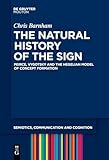The Natural History of the Sign : Peirce, Vygotsky and the Hegelian Model of Concept Formation / Chris Barnham.
Material type: TextSeries: Semiotics, Communication and Cognition [SCC] ; 29Publisher: Berlin ; Boston : De Gruyter Mouton, [2022]Copyright date: ©2022Description: 1 online resource (XI, 244 p.)Content type:
TextSeries: Semiotics, Communication and Cognition [SCC] ; 29Publisher: Berlin ; Boston : De Gruyter Mouton, [2022]Copyright date: ©2022Description: 1 online resource (XI, 244 p.)Content type: - 9783110695717
- 9783110695922
- 9783110695854
- 121.68
- online - DeGruyter
- Issued also in print.
| Item type | Current library | Call number | URL | Status | Notes | Barcode | |
|---|---|---|---|---|---|---|---|
 eBook
eBook
|
Biblioteca "Angelicum" Pont. Univ. S.Tommaso d'Aquino Nuvola online | online - DeGruyter (Browse shelf(Opens below)) | Online access | Not for loan (Accesso limitato) | Accesso per gli utenti autorizzati / Access for authorized users | (dgr)9783110695854 |
Frontmatter -- Acknowledgments -- Contents -- Introduction: Hegel, Peirce, and Vygotsky -- Part One: Perception and the model of ‘secondary dualism’ -- 1 The model of ‘secondary dualism’ -- 2 Semiotics and ‘secondary dualism’ -- 3 Hegel, Peirce, and Vygotsky: Models of perception -- Part Two: Concept formation as mediation -- 4 Hegel’s template of concept formation -- 5 Peirce: The three categories -- 6 Mediation in Peirce: The structure of the sign -- 7 Mediation in Vygotsky: ‘Word meaning’ -- Part Three: Concept formation in Peirce and Vygotsky -- 8 Peirce: The classification of signs and the first trichotomy -- 9 The received view of the Peircean icon -- 10 Peirce: Concept formation in the second trichotomy -- 11 Peirce: The third trichotomy -- 12 Vygotsky on concept formation -- Part Four: Peirce: The implications of semiotic concept formation -- 13 Pragmatism, truth and abduction -- 14 Peircean semiotics and learning theory -- References -- Index
restricted access online access with authorization star
http://purl.org/coar/access_right/c_16ec
Our understanding of CS Peirce, and his semiotics, is largely influenced by a twentieth century perspective that prioritizes the sign as a cultural artifact, or as one that that 'distorts', in some way, our understanding of the empirical world. Such a perspective will always undermine appreciation of Peirce as a philosopher who viewed signs as the very mechanisms that enable us to understand reality through concept formation. The key to this repositioning of Peirce is to place his work in the broad frame of Hegelian philosophy. This book evaluates, in detail, the parallels that exist between Peircean and Hegelian thought, highlighting their convergences and also the points at which Peirce departs from Hegel's position. It also considers the work of Vygotsky on concept formation showing that both are, in fact, working within the same Hegelian template. This book, therefore, contributes to our broader understanding of Peircean semiotics. But by drawing in Vygotsky, under the same theoretical auspices, it demonstrates that Peirce has much to offer contemporary educational learning theory.
Issued also in print.
Mode of access: Internet via World Wide Web.
In English.
Description based on online resource; title from PDF title page (publisher's Web site, viewed 25. Jun 2024)


